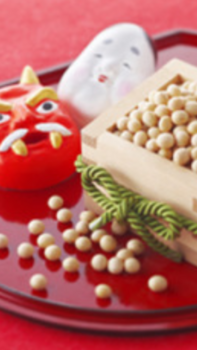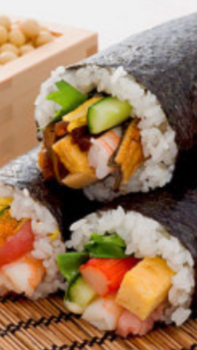節分を英語で言いたい [アンデルセン・イングリッシュ・スクール]
アンデルセン イングリッシュ スクールのソフィです。
節分と言えば「鬼は外。福は内」と豆まきですね。
しかし最近はとても「恵方巻き」が定着して来ましたね。
日本が長いネイティブ外国人も、
この時期にコンビニやスーパーで太巻きをよく見るのか不思議に思っている人が多いようです。
今年は節分を英語で説明してみましょう。★

外国人の友達に節分をどうやって説明しますか?
日本の節分の行事についてしっかり伝えましょうね。
スポンサーリンク
★ February 3rd is the day of Setsubun.
2月3日は節分の日です。
★ Setsubun refers to the day before the beginning of each season
(the first days of spring, summer, fall and winter).
節分とは各季節の始まりの日、立春・立夏・立秋・立冬の前日のことです。
★ The literal meaning of the word Setsubun is “division of the seasons,”
節分は季節を分けるという意味です。
★ Out of all the 4 Setsubun days,
Risshun (the first day of spring) is the most special day.
4つの節分の中で立春は特別に大切な日です。
★ Back in the day, the Japanese new year started on Risshun (The first day of spring).
昔は立春から新しい年が始まりました。
★ Modern day New Year’s Eve was the Setsubun day of Risshun.
今でいう、大晦日が立春の節分の日です。
★ Setsubun signifies the ending of winter and the beginning of spring.
節分は冬が終わって春になることを意味しています。
★ Setsubun is the coldest day of the year.
節分は1年で1番寒くなる日です。
★ It is believed that (oni )come when the seasons change in Japan.
(Oni) a devil-like creature from Japanese folklore.
日本では季節の変わり目は鬼がやってくると言われています。
★ It is believed that There are many rituals to exorcise these oni.
鬼を追い払うためのさまざまな儀式などがあります。
★ The rituals differ in each region.
地方によって儀式は異なります。
スポンサーリンク
★★ 豆まきについて ★★
★ Throwing roasted soybeans was first practiced back in the Heian period,
to stop oni from attacking villages by throwing beans at their eyes.
豆まきは平安時代に鞍馬山の鬼が都で悪さをするのを、大豆を投げて鬼の目をつぶし、
災難を逃れたのが始まりです。
★ The term oni refers to an invisible negative vibes called jaki in Japanese.
「鬼」とは目に見えない気、「邪気」のことを指します。
★To get rid of the oni,
people scatter roasted soy beans both inside and outside of their houses.
鬼を追い払うために炒った大豆を家の中と外に撒きます。
★ These roasted soy beans are called fukumame.
炒った大豆のことを「福豆」といいます。
★ In order to instill god’s power in the fukumame,
they are to be placed on the household altar until Setsubun.
福豆は神様の力が宿るように、節分の日まで神棚にお供えします。
★ Traditionally, the husband or the male person of the year took part in the practice,
but it has now become a family-wide event to take in good luck for all family members.
本来は一家の主人か、その家の年男だけが撒く風習でしが、
現在は一家みんなに福がくるように家族全員で豆まきをします。
★ It has become the dad’s job to wear an onimask and have soybeans thrown at him.
お父さんは鬼のお面をつけて鬼役をさせられ豆をぶつけられます。
★ The phrase “Out with the devil! In with good fortune,” is said when throwing soybeans.
豆を蒔く時には「福はうち、鬼はそと」と掛け声をあげます。
★ When saying “Out with the devil,” open a window and throw beans twice.
Make sure to close the window immediately so the onidoesn’t come back.
「鬼はそと」と言う時は窓を開けて2回豆を撒きます。
鬼が戻らないように窓をすぐ閉めましょう。
★ When saying “In with good fortune,” throw soy beans twice inside the house.
「福はうち」という時は部屋の中に2回豆を撒きます。
★ Once the beans are thrown, gather them all up and eat the same number of beans as your age. Eat one extra to keep you from sickness and stay healthy for the whole year.
撒いた豆を拾い、歳の数よりひとつ多く食べるとその年の1年風邪をひかず、
健康でいることができます。
スポンサーリンク
★★ 恵方巻について ★★

★ Ehomaki is a sushi roll that is believed to be good luck when eaten on Setsubun day.
This custom began in the Kansai area but now it has become a nationwide event and Ehomakiis sold at supermarkets and convenience stores.
恵方巻は節分に食べると縁起がいいと関西地方から始まった風習で、
今では全国に広まりスーパーやコンビニでも売られています。
★ Other names are "Maru kaburi sushi," "Eho sushi," and"Kippo Maki."
恵方巻のほかに、「丸かぶり寿司」「恵方寿司」「吉方巻き」とも呼ばれています。
★ When eating Ehomaki,
look in the year’s good luck direction, and eat quietly while making a wish.
恵方巻は、節分の夜にその年の恵方に向かって、
願いごとを思い浮かべながら丸かじりで無言で食べます。
★ Ehomaki should not be cut. This represents not cutting any good bonds in the future.
恵方巻は切らず1本丸ごと食べます。縁を切らないという意味が込められています。
★ The 7 filling inside Ehomaki represent the 7 gods.
This has the meaning of “rolling in goodness (luck).”
恵方巻の具は、七福神に因んだ7種類です。
福を巻き込むという意味も含まれています。
★ Recently, there have been a lot of Japanese snacks and cakes that replicate ehomaki.
最近では恵方巻に因んだ和菓子やケーキなどの御菓子も登場しています。
スポンサーリンク
★★ 地方の風習について ★★
★ Some regions say “In with good fortune, onias well.”
地域によっては、「福はうち、鬼もうち」という掛け声もあります。
★ Some regions throw peanuts instead of roasted soy beans.
炒った大豆をではなく、落花生を投げる地域もあります。
★ In order to avoid evil, people put sardine head at the entrance of the house.
This is to avoid goblins with the sardine smell.
魔よけのために鰯の頭を玄関に飾り付けます。
鰯の臭いで鬼を寄せ付けさせないようにするためです。
★ There is a custom of drinking fukucha,
a tea which beans and green tea are brewed together.
福茶といってお豆と茶葉を一緒に煎じて飲みます。
以上今回は、節分の時によく使う英語の表現を紹介しました。
★ 節分 → Setsubun
★ 豆まきをする → scatter parched beans
★ 恵方巻き → Eho-maki
外国人の中には、日本の文化に興味を持ち、
日本の伝統行事のことを詳しく知りたい人も大勢いますよ。★

日本の文化について聞かれた時に
きちんと英語で説明できたら相手も満足できますね。
何かかっこいいですよね。
スポンサーリンク
もし機会があれば、節分の日に外国人の友達と一緒に
“Good luck in! Devils out!”
と楽しんでみてはいかがでしょうか。
************************************
知らなきゃ損する英語の勉強方法?!
高松駅近く
アンデルセンイングリッシュスクール
フォニックスで習う英会話スクール
↓ ↓ ↓ ↓ ↓ ↓ ↓ ↓
http://xn--cck7b9a1jnbd.xyz/
************************************
最後までお読みいただきありがとうございました。
この記事もよく読まれています
↓ ↓ ↓ ↓ ↓ ↓ ↓ ↓
バレンタインに贈る英語で言いたいメッセージ
英語で言いたい 「よろしくお願いします」
英語で言いたい新年の挨拶フレーズ
ローラ バイオハザードですぐ死んだね? 短い出演だったの?
ローラ バイオハザードなぜちょい役出演?まさかのオーディションから!
スポンサーリンク
節分と言えば「鬼は外。福は内」と豆まきですね。
しかし最近はとても「恵方巻き」が定着して来ましたね。
日本が長いネイティブ外国人も、
この時期にコンビニやスーパーで太巻きをよく見るのか不思議に思っている人が多いようです。
今年は節分を英語で説明してみましょう。★

外国人の友達に節分をどうやって説明しますか?
日本の節分の行事についてしっかり伝えましょうね。
★ February 3rd is the day of Setsubun.
2月3日は節分の日です。
★ Setsubun refers to the day before the beginning of each season
(the first days of spring, summer, fall and winter).
節分とは各季節の始まりの日、立春・立夏・立秋・立冬の前日のことです。
★ The literal meaning of the word Setsubun is “division of the seasons,”
節分は季節を分けるという意味です。
★ Out of all the 4 Setsubun days,
Risshun (the first day of spring) is the most special day.
4つの節分の中で立春は特別に大切な日です。
★ Back in the day, the Japanese new year started on Risshun (The first day of spring).
昔は立春から新しい年が始まりました。
★ Modern day New Year’s Eve was the Setsubun day of Risshun.
今でいう、大晦日が立春の節分の日です。
★ Setsubun signifies the ending of winter and the beginning of spring.
節分は冬が終わって春になることを意味しています。
★ Setsubun is the coldest day of the year.
節分は1年で1番寒くなる日です。
★ It is believed that (oni )come when the seasons change in Japan.
(Oni) a devil-like creature from Japanese folklore.
日本では季節の変わり目は鬼がやってくると言われています。
★ It is believed that There are many rituals to exorcise these oni.
鬼を追い払うためのさまざまな儀式などがあります。
★ The rituals differ in each region.
地方によって儀式は異なります。
★★ 豆まきについて ★★
★ Throwing roasted soybeans was first practiced back in the Heian period,
to stop oni from attacking villages by throwing beans at their eyes.
豆まきは平安時代に鞍馬山の鬼が都で悪さをするのを、大豆を投げて鬼の目をつぶし、
災難を逃れたのが始まりです。
★ The term oni refers to an invisible negative vibes called jaki in Japanese.
「鬼」とは目に見えない気、「邪気」のことを指します。
★To get rid of the oni,
people scatter roasted soy beans both inside and outside of their houses.
鬼を追い払うために炒った大豆を家の中と外に撒きます。
★ These roasted soy beans are called fukumame.
炒った大豆のことを「福豆」といいます。
★ In order to instill god’s power in the fukumame,
they are to be placed on the household altar until Setsubun.
福豆は神様の力が宿るように、節分の日まで神棚にお供えします。
★ Traditionally, the husband or the male person of the year took part in the practice,
but it has now become a family-wide event to take in good luck for all family members.
本来は一家の主人か、その家の年男だけが撒く風習でしが、
現在は一家みんなに福がくるように家族全員で豆まきをします。
★ It has become the dad’s job to wear an onimask and have soybeans thrown at him.
お父さんは鬼のお面をつけて鬼役をさせられ豆をぶつけられます。
★ The phrase “Out with the devil! In with good fortune,” is said when throwing soybeans.
豆を蒔く時には「福はうち、鬼はそと」と掛け声をあげます。
★ When saying “Out with the devil,” open a window and throw beans twice.
Make sure to close the window immediately so the onidoesn’t come back.
「鬼はそと」と言う時は窓を開けて2回豆を撒きます。
鬼が戻らないように窓をすぐ閉めましょう。
★ When saying “In with good fortune,” throw soy beans twice inside the house.
「福はうち」という時は部屋の中に2回豆を撒きます。
★ Once the beans are thrown, gather them all up and eat the same number of beans as your age. Eat one extra to keep you from sickness and stay healthy for the whole year.
撒いた豆を拾い、歳の数よりひとつ多く食べるとその年の1年風邪をひかず、
健康でいることができます。
★★ 恵方巻について ★★

★ Ehomaki is a sushi roll that is believed to be good luck when eaten on Setsubun day.
This custom began in the Kansai area but now it has become a nationwide event and Ehomakiis sold at supermarkets and convenience stores.
恵方巻は節分に食べると縁起がいいと関西地方から始まった風習で、
今では全国に広まりスーパーやコンビニでも売られています。
★ Other names are "Maru kaburi sushi," "Eho sushi," and"Kippo Maki."
恵方巻のほかに、「丸かぶり寿司」「恵方寿司」「吉方巻き」とも呼ばれています。
★ When eating Ehomaki,
look in the year’s good luck direction, and eat quietly while making a wish.
恵方巻は、節分の夜にその年の恵方に向かって、
願いごとを思い浮かべながら丸かじりで無言で食べます。
★ Ehomaki should not be cut. This represents not cutting any good bonds in the future.
恵方巻は切らず1本丸ごと食べます。縁を切らないという意味が込められています。
★ The 7 filling inside Ehomaki represent the 7 gods.
This has the meaning of “rolling in goodness (luck).”
恵方巻の具は、七福神に因んだ7種類です。
福を巻き込むという意味も含まれています。
★ Recently, there have been a lot of Japanese snacks and cakes that replicate ehomaki.
最近では恵方巻に因んだ和菓子やケーキなどの御菓子も登場しています。
★★ 地方の風習について ★★
★ Some regions say “In with good fortune, onias well.”
地域によっては、「福はうち、鬼もうち」という掛け声もあります。
★ Some regions throw peanuts instead of roasted soy beans.
炒った大豆をではなく、落花生を投げる地域もあります。
★ In order to avoid evil, people put sardine head at the entrance of the house.
This is to avoid goblins with the sardine smell.
魔よけのために鰯の頭を玄関に飾り付けます。
鰯の臭いで鬼を寄せ付けさせないようにするためです。
★ There is a custom of drinking fukucha,
a tea which beans and green tea are brewed together.
福茶といってお豆と茶葉を一緒に煎じて飲みます。
以上今回は、節分の時によく使う英語の表現を紹介しました。
★ 節分 → Setsubun
★ 豆まきをする → scatter parched beans
★ 恵方巻き → Eho-maki
外国人の中には、日本の文化に興味を持ち、
日本の伝統行事のことを詳しく知りたい人も大勢いますよ。★

日本の文化について聞かれた時に
きちんと英語で説明できたら相手も満足できますね。
何かかっこいいですよね。
もし機会があれば、節分の日に外国人の友達と一緒に
“Good luck in! Devils out!”
と楽しんでみてはいかがでしょうか。
************************************
知らなきゃ損する英語の勉強方法?!
高松駅近く
アンデルセンイングリッシュスクール
フォニックスで習う英会話スクール
↓ ↓ ↓ ↓ ↓ ↓ ↓ ↓
http://xn--cck7b9a1jnbd.xyz/
************************************
最後までお読みいただきありがとうございました。
この記事もよく読まれています
↓ ↓ ↓ ↓ ↓ ↓ ↓ ↓
バレンタインに贈る英語で言いたいメッセージ
英語で言いたい 「よろしくお願いします」
英語で言いたい新年の挨拶フレーズ
ローラ バイオハザードですぐ死んだね? 短い出演だったの?
ローラ バイオハザードなぜちょい役出演?まさかのオーディションから!
2017-01-15 22:54
nice!(0)
コメント(0)
トラックバック(0)



コメント 0